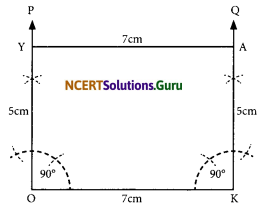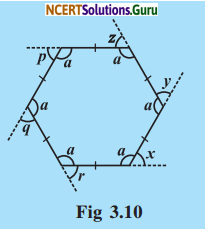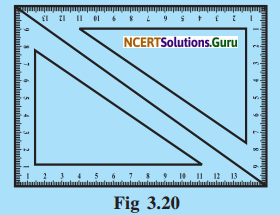These NCERT Solutions for Class 7 Maths Chapter 4 Simple Equations Ex 4.2 Questions and Answers are prepared by our highly skilled subject experts.
NCERT Solutions for Class 7 Maths Chapter 4 Simple Equations Exercise 4.2
Question 1.
Give first step you will use to separate the variable and then solve the equation:
(a) x – 1 = 0
(b) x + 1 = 0
(c) x – 1 = 5
(d) x + 6 = 2
(e) y – 4 = -7
(f) y – 4 = 4
(g) y + 4 = 4
(h) y + 4 = – 4
Answer:
(a) x – 1 = 0
Adding 1 on both sides, we get.
x – 1 + 1 = 0 + 1
x = 1
The solution is x = 1.
(b) x + 1 = 0
Subtracting 1 from both sides, we get.
x + 1 – 1 = 0 – 1
x = -1.
The solution is x = – 1
(c) x – 1 = 5
Adding 1 to both sides, we get.
x – 1 + 1 = 5 + 1
x = 6
The solution is x = 6.
(d) x + 6 = 2
Subtracting 6 from both sides, we get
x + 6 – 6 = 2 – 6
x = – 4
The solution is x = – 4.
(e) y – 4 = – 7
Adding 4 on both sides, we get
y – 4 + 4 = -7 + 4
y = – 3
The solution is y = – 3.
(f) y – 4 = 4
Adding + 4 on both sides, we get
y – 4 + 4 = 4 + 4
y = 8
The solution is y = 8.
(g) y + 4 = 4
Subtracting 4 from both sides, we get
y + 4 – 4 = 4 – 4
y = 0
The solution is y = 0.
(h) y + 4 = – 4
Adding – 4 on both sides, we get
y + 4 – 4 = -4 -4
y = – 8
The solution is y = – 8.

Question 2.
Give first step you will use to separate the variable and then solve the equation:
(a) 31 = 42
(b) \(\frac{\mathrm{b}}{2}\) = 6
(c) \(\frac{\mathrm{p}}{7}\) = 4
(d) 4x = 25
(e) 8y = 36
(f) \(\frac{z}{3}=\frac{5}{4}\)
(g) \(\frac{a}{5}=\frac{7}{15}\)
(h) 20t = -10
Answer:
(a) 31 = 42
Dividing both sides by 3, we get
\(\frac{31}{3}=\frac{42}{3}\)
1 = 14
The solution is 1 = 14.
(b) \(\frac{\mathrm{b}}{2}\) = 6
Multiplying both sides by 2, we get. b
\(\frac{\mathrm{b}}{2}\) × 2 = 6 × 2
b = 12
The solution is b = 12.
(c) \(\frac{\mathrm{p}}{7}\) = 4
Multiplying both sides by 7, we get
\(\frac{\mathrm{p}}{7}\) × 7 = 4 × 7
p = 28
The solution is p = 28.
(d) 4x = 25
Dividing both sides by 4, we get
\(\frac{4 x}{4}=\frac{25}{4}\)
x = \(\frac{25}{4}\)
The solution is x = \(\frac{25}{4}\) or x = 6 \(\frac{1}{4}\) .
(e) 8y = 36
Dividing both sides by 8, we get
\(\frac{8 y}{8}=\frac{36}{8}\)
y = \(\frac{9}{2}\)
The solution is y = \(\frac{9}{2}\) or y = 4 \(\frac{1}{2}\)
(f) (f) \(\frac{z}{3}=\frac{5}{4}\)
Multiplying both sides by 3, we get
\(\frac{z}{3}\) × 3 = \(\frac{5}{4}\) × 3
z = \(\frac{25}{4}\)
The solution is z = \(\frac{15}{4}\) or y = 3 \(\frac{3}{4}\)
(g) \(\frac{a}{5}=\frac{7}{15}\)
Multiplying both sides by 5, we get
\(\frac{a}{5}\) × 5 = \(\frac{7}{15}\) × 5
a = \(\frac{7}{3}\)
The solution is a = \(\frac{7}{3}\) or a = 2 \(\frac{1}{3}\).
(h) 20t = – 10
Dividing both sides by 20, we get
\(\frac{20 \mathrm{t}}{20}=\frac{-10}{20}\)
t = \(\frac{-1}{2}\)
The solution is t = \(\frac{-1}{2}\).

Question 3.
Give the steps you will use to separate the variable and then solve the equation:
(a) 3n – 2 = 46
(b) 5m +7 = 17
(c) \(\frac{20 \mathrm{p}}{3}\) = 40
(d) \(\frac{3 \mathrm{p}}{10}\) = 6
Answer:
(a) 3n – 2 = 46
Adding 2 on both sides, we get
3n – 2 + 2 =46 + 2
3n = 48
Dividing both sides by 3, we get
\(\frac{3 n}{3}=\frac{48}{3}\)
n = 16
The solution is n = 16.
(b) 5m + 7 = 17
Adding – 7 on both sides, we get
5m + 7 – 7 = 17 – 7
5m = 10
Dividing both sides by 5, we get
\(\frac{5 m}{5}=\frac{10}{5}\)
m = 2
The solution is m = 2
(c) \(\frac{20 \mathrm{p}}{3}\) = 40
Multiplying both sides by 3, we get.
\(\frac{20 \mathrm{p}}{3}\) × 3 = 40 × 3
20 p = 120
Dividing both sides by 20 we get.
\(\frac{20 p}{20}=\frac{120}{20}\)
p = 6
The solution is p = 6.
(d) \(\frac{3 \mathrm{p}}{10}\) = 6
Multiplying both sides by 10, we get 3p
\(\frac{3 \mathrm{p}}{10}\) × 10 = 6 × 10
3p = 60
Dividing both sides by 3, we get
\(\frac{3 p}{3}=\frac{60}{3}\)
p = 20
The solution is p = 20.

Question 4.
Solve the following equations:
(a) 10p = 100
(b) 10p + 10 = 100
(c) \(\frac{\mathrm{p}}{4}\)
(d) \(\frac{-p}{3}\) = 5
(e) \(\frac{3 \mathrm{p}}{4}\) = 6
(f) 3s = – 9
(g) 3s + 12 = 0
(h) 3s = 0
(i) 2q = 6
(j) 2q – 6 = 0
(k) 2q + 6 = 0
(l) 2q + 6 = 12
Answer:
(a) 10p = 100
Dividing both sides by 10, we get
\(\frac{10 \mathrm{p}}{10}=\frac{100}{10}\)
p = 10 10p = 90
The solution is p = 10.
(b) 10p + 10 = 100
10p + 10 – 10= 100 – 10
Dividing both sides by 10, we get
\(\frac{10 p}{10}=\frac{90}{10}\)
p = 9
The solution is p = 9.
(c) \(\frac{\mathrm{p}}{4}\) = 5
Multiplying both sides by 4, we get
\(\frac{\mathrm{p}}{4}\) × 4 = 5 × 4
p = 20
The solution is p = 20.
(d) \(\frac{-p}{3}\) = 5
Multiplying both sides by 3, we get
-p = 15
\(\frac{-p}{3}\) × 3 = 5 × 3
Multiplying both sides by (- 1)
– p × (- 1)= 15 × (- 1)
p = – 15
The solution is p = -15.
(e) \(\frac{3 \mathrm{p}}{4}\) = 6
Multiplying both sides by 4, we get
\(\frac{3 \mathrm{p}}{4}\) × 4 = 6 × 4
3p = 24
Dividing both sides by 3, we get
\(\frac{3 p}{3}=\frac{24}{3}\)
p = 8
The solution is p = 8.
(f) 3s = – 9
Dividing both sides by 3, we get
\(\frac{3 s}{3}=\frac{-9}{3}\)
s = – 3
The solution is s = – 3.
(g) 3s + 12 = 0
Subtracting 12 from both sides, we get
3s + 12- 12 = 0 – 12
3s = – 12
Dividing both sides by 3, we get
\(\frac{3 s}{3}=\frac{-12}{3}\)
s = – 4
The solution is s = – 4.

(h) 3s =0
Dividing both sides by 3, we get
\(\frac{3 s}{3}=\frac{0}{3}\)
s = 0
The solution is s = 0.
(i) 2q = 6
Dividing both sides by 2, we get
\(\frac{2 \mathrm{q}}{2}=\frac{6}{2}\)
q = 3
The solution is q = 3.
(j) 2q – 6 = 0
Adding 6 on both sides, we get
2q – 6 + 6= 0 + 6
2q = 6
Dividing both sides by 2, we get
\(\frac{2 \mathrm{q}}{2}=\frac{6}{2}\)
q = 3
The solution is q = 3.
(k) 2q + 6 =0
Subtracting 6 from both sides, we get
2q + 6 – 6 = 0 – 6
2q = – 6
Dividing both sides by 2, we get
\(\frac{2 q}{2}=\frac{-6}{2}\)
q = -3
The solution is q = – 3.
(l) 2q + 6 =12
Subtracting 6 from both sides, we get
2q + 6 – 6 = 12 – 6
2q = 6
Dividing both sides by 2, we get
\(\frac{2 \mathrm{q}}{2}=\frac{6}{2}\)
q = 3
The solution is q = 3.
![]()

![]()













